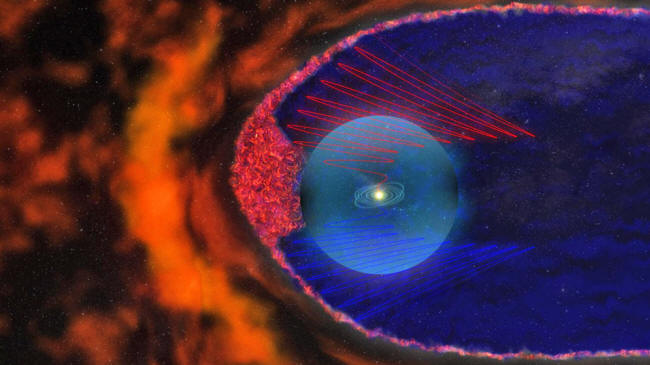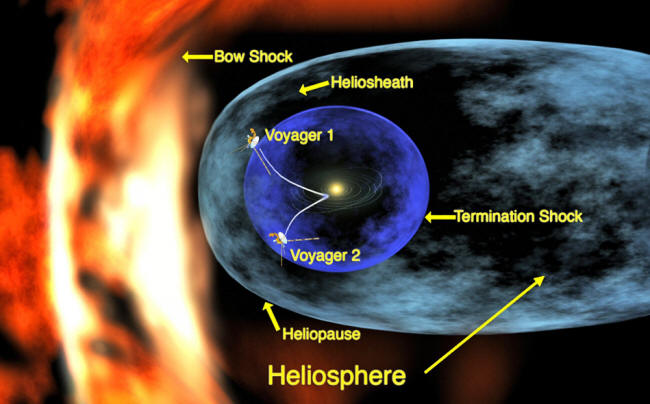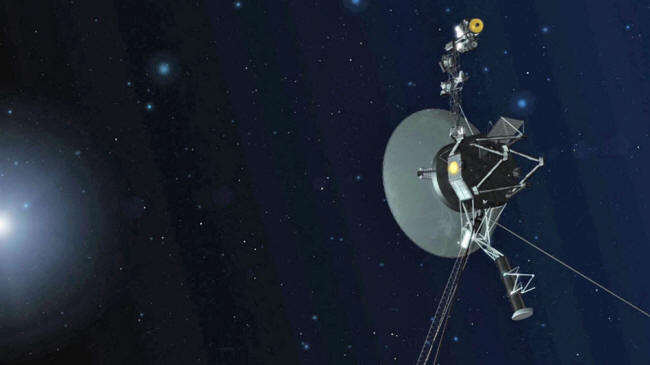|

by Matthew Hart
November 20,
2019
from
Nerdist Website

Imagine you're running the faucet above a sink, and picture
specifically the way the falling water from the faucet continuously
splashes outward against the bowl, creating a little area where the
standing water in the bowl can't invade.
It turns out the Sun does
kind of the same thing as the water falling from the faucet, only
instead of flinging water outward, it flings solar wind in every
direction, and instead of standing water around it, there's a
particle soup made up of interstellar plasma.
And while scientists have
known about this dynamic for years, they've now discovered, thanks
to the Voyager 2 space probe, that the region around the outer edge
of our "shield" made up of solar wind, which clashes with the
interstellar plasma soup, consists of an 89,000 ºF (49,500 ºC) wall
of (low density) plasma.
Anton
Petrov's video
describing the
wall of plasma
around our solar system.
The sphere of piping hot plasma - which, again, is low density,
meaning Voyager 2 can pass right through it without a problem -
is discussed in the video above from YouTuber and high school
science, math, and computer science teacher,
Anton Petrov.
In the above video, which comes
via
Digital Journal, Petrov discusses one of NASA's latest
discoveries, made when its
Voyager 2 space probe (launched in '77)
began passing through a region surrounding our solar system known as
the
heliopause.
In this region, Voyager 2
discovered the spherical wall of interstellar plasma, which Petrov
calls a "wall of fire."
That,
"wall of fire,"
Petrov notes, can be thought of as "an actual physical barrier," and is "almost like a wall of hot plasma and... cosmic
radiation that suddenly jumps up as soon as we cross into the
so-called
interstellar space."
That wall of hot plasma
ranges in temperature from 30,000 to 50,000 ºC (roughly 53,000
to 89,000 ºF), according to a paper (Voyager
2 Plasma Observations of the Heliopause and Interstellar Medium) published
earlier this month in the journal Nature Astronomy.
In the abstract for that
paper, the authors say ,
"The [very
local interstellar medium, a.k.a. the wall of hot plasma] is
variable near the [heliopause] and hotter than expected."
The abstract also notes
that,
"Voyager 2
observations show that the temperature [in that region] is
30,000-50,000 ºC, whereas models and observations predicted a
[very local interstellar medium] temperature of
15,000-30,000 ºC."
Scientists have
discovered that the wall of hot plasma around our solar system is a
whopping 89,000 ºF (49,500 ºC).

An image showing, in part,
where
the heliopause interacts
with
interstellar plasma.
NASA/Walt Feimer
Needless to say, we earthlings are ridiculously lucky to have that
solar-wind shield.
The heliosphere, which the Sun provides, blocks
out 70% of the interstellar
cosmic rays.
If we didn't have the
heliosphere, those cosmic rays would otherwise charge in and
interact with us here on Earth, causing a serious uptick in the
amount of radiation we'd absorb.

An illustration of Voyager 2,
which
recorded the temperature of the wall of plasma.
NASA/JPL-Caltech
It's unclear how difficult this wall of hot plasma will make
interstellar travel, once we decide to go beyond Mars and eventually
leave our solar system, but considering both Voyager 2, and even
Voyager 1 (also launched in '77) made it through OK, it seems like
at least our interstellar ships wouldn't be too negatively affected.
Although it's unclear how
the plasma wall will affect we biological beings.
Regardless, the discovery
is exciting because, as
JPL notes, this is the,
"cosmic shoreline...
where the environment created by our Sun ends and the vast ocean
of interstellar space begins."
|




